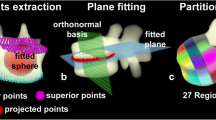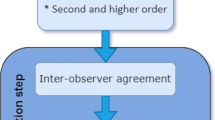Abstract
Summary
This study investigated the feasibility of opportunistic osteoporosis screening in routine contrast-enhanced MDCT exams using texture analysis. The results showed an acceptable reproducibility of texture features, and these features could discriminate healthy/osteoporotic fracture cohort with an accuracy of 83%.
Introduction
This aim of this study is to investigate the feasibility of opportunistic osteoporosis screening in routine contrast-enhanced MDCT exams using texture analysis.
Methods
We performed texture analysis at the spine in routine MDCT exams and investigated the effect of intravenous contrast medium (IVCM) (n = 7), slice thickness (n = 7), the long-term reproducibility (n = 9), and the ability to differentiate healthy/osteoporotic fracture cohort (n = 9 age and gender matched pairs). Eight texture features were extracted using gray level co-occurrence matrix (GLCM). The independent sample t test was used to rank the features of healthy/fracture cohort and classification was performed using support vector machine (SVM).
Results
The results revealed significant correlations between texture parameters derived from MDCT scans with and without IVCM (r up to 0.91) slice thickness of 1 mm versus 2 and 3 mm (r up to 0.96) and scan-rescan (r up to 0.59). The performance of the SVM classifier was evaluated using 10-fold cross-validation and revealed an average classification accuracy of 83%.
Conclusions
Opportunistic osteoporosis screening at the spine using specific texture parameters (energy, entropy, and homogeneity) and SVM can be performed in routine contrast-enhanced MDCT exams.






Similar content being viewed by others
References
Klibanski A, Adams-Campbell L, Bassford T, Blair SN, Boden SD, Dickersin K, Gifford DR, Glasse L, Goldring SR, Hruska K et al (2001) Osteoporosis prevention, diagnosis, and therapy. J Am Med Assoc 285(6):785–795
Baum T, Garcia EG, Burgkart R, Gordijenko O, Liebl H, Jungmann PM, Gruber M, Zahel T, Rummeny EJ, Waldt S et al (2015) Osteoporosis imaging: effects of bone preservation on mdct-based trabecular bone microstructure parameters and finite element models. BMC Med Imaging 15(1):1
Mookiah MRK, Baum T, Mei K, Kopp FK, Kaissis G, Foehr P, Noel PB, Kirschke JS, Subburaj K (2017) Effect of radiation dose reduction on texture measures of trabecular bone microstructure: an in vitro study. J Bone Miner Metab:1–13. https://doi.org/10.1007/s00774-017-0836-5
Bauer JS, Sidorenko I, Mueller D, Baum T, Issever AS, Eckstein F, Rummeny EJ, Link TM, Raeth CW (2014) Prediction of bone strength by μ ct and mdct-based finite-element-models: how much spatial resolution is needed? Eur J Radiol 83(1):e36–e42
Mei K, Kopp FK, Bippus R, Köhler T, Schwaiger BJ, Gersing AS, Fehringer A, Sauter A, Münzel D, Pfeiffer F et al (2017) Is multidetector ct-based bone mineral density and quantitative bone microstructure assessment at the spine still feasible using ultra-low tube current and sparse sampling? Eur Radiol 27(12):5261–5271
Anitha D, Subburaj K, Mei K, Kopp FK, Foehr P, Noel PB, Kirschke JS, Baum T (2016) Effects of dose reduction on bone strength prediction using finite element analysis. Sci Rep 6:38441
Showalter C, Clymer BD, Richmond B, Powell K (2006) Three-dimensional texture analysis of cancellous bone cores evaluated at clinical ct resolutions. Osteoporos Int 17(2):259–266
Petrou M, Sevilla PG (2006) Image processing: dealing with texture, vol 1. Wiley Online Library
Pachon JH, Yadava G, Pal D, Hsieh J (2012) Image quality evaluation of iterative ct reconstruction algorithms: a perspective from spatial domain noise texture measures. In: Proceedings of the SPIE, vol 8313, p 83132k
Valentinitsch A, Patsch JM, Burghardt AJ, Link TM, Majumdar S, Fischer L, Schueller-Weidekamm C, Resch H, Kainberger F, Langs G (2013) Computational identification and quantification of trabecular microarchitecture classes by 3-d texture analysis-based clustering. Bone 54(1):133–140
Vrtiska TJ, Hartman RP, Kofler JM, Bruesewitz MR, King BF, McCollough CH (2009) Spatial resolution and radiation dose of a 64-mdct scanner compared with published ct urography protocols. Am J Roentgenol 192(4):941–948
Wang H-y, Su Z-h, Xu X, Sun Z-p, Duan F-x, Song Y-y, Li L, Wang Y-w, Ma X, Guo A-t et al (2016) Dynamic contrast-enhanced mr imaging in renal cell carcinoma: reproducibility of histogram analysis on pharmacokinetic parameters. Sci Rep 6:29146
Wolf I, Vetter M, Wegner I, Böttger T, Nolden M, Schöbinger M, Hastenteufel M, Kunert T, Meinzer H-P (2005) The medical imaging interaction toolkit. Med Image Anal 9(6):594–604
Müller D, Bauer JS, Zeile M, Rummeny EJ, Link TM (2008) Significance of sagittal reformations in routine thoracic and abdominal multislice ct studies for detecting osteoporotic fractures and other spine abnormalities. Eur Radiol 18(8):1696–1702
Haralick RM, Shanmugam K et al (1973) Textural features for image classification. IEEE Trans Syst Man Cybern 3(6):610–621
Vallières M, Freeman CR, Skamene SR, El Naqa I (2015) A radiomics model from joint fdg-pet and mri texture features for the prediction of lung metastases in soft-tissue sarcomas of the extremities. Phys Med Biol 60(14):5471
Cortes C, Vapnik V (1995) Support vector machine. Mach Learn 20(3):273–297
Bland JM, Altman D (1986) Statistical methods for assessing agreement between two methods of clinical measurement. The Lancet 327(8476):307–310
Zhao Q, Shi C-Z, Luo L-P (2014) Role of the texture features of images in the diagnosis of solitary pulmonary nodules in different sizes. Chin J Cancer Res 26(4):451
Mookiah MRK, Acharya UR, Lim CM, Petznick A, Suri JS (2012) Data mining technique for automated diagnosis of glaucoma using higher order spectra and wavelet energy features. Knowl-Based Syst 33:73–82
Ferrari RJ, Rangayyan RM, Desautels JL, Frère AF (2001) Analysis of asymmetry in mammograms via directional filtering with gabor wavelets. IEEE Trans Med Imaging 20(9):953–964
Qian W, Zhukov T, Song D, Tockman MS (2007) Computerized analysis of cellular features and biomarkers for cytologic diagnosis of early lung cancer. Anal Quant Cytol Histol/the International Academy of Cytology [and] American Society of Cytology 29(2):103–111
Nielsen B, Hveem TS, Kildal W, Abeler VM, Kristensen GB, Albregtsen F, Danielsen HE (2015) Entropy-based adaptive nuclear texture features are independent prognostic markers in a total population of uterine sarcomas. Cytometry A 87(4):315–325
Ferrari RJ, Rangayyan RM, Desautels JL, Frere AF (2001) Analysis of asymmetry in mammograms via directional filtering with gabor wavelets. IEEE Trans Med Imaging 20(9):953–964
Dhara AK, Mukhopadhyay S, Khandelwal N (2013) 3D texture analysis of solitary pulmonary nodules using co-occurrence matrix from volumetric lung ct images. In: SPIE medical imaging, international society for optics and photonics, pp 867039–867039
Raja J, Khan M, Ramachandra V, Al-Kadi O Texture analysis of ct images in the characterization of oral cancers involving buccal mucosa. Dentomaxillofac Radiol 41(6):475–480
Funding
This work was supported by the Deutsche Forschungsgemeinschaft DFG BA 4906/2-1 (Thomas Baum) and Singapore University of Technology and Design (SUTD) Start-up Research Grant SRG EPD 2015 093 (Karupppasamy Subburaj). The funding agencies had no role in study design, data collection, and analysis, decision to publish, or preparation of the manuscript.
Author information
Authors and Affiliations
Corresponding author
Ethics declarations
Conflict of interests
The authors declare that they have no conflict of interest.
Electronic supplementary material
Below is the link to the electronic supplementary material.
Rights and permissions
About this article
Cite this article
Mookiah, M.R.K., Rohrmeier, A., Dieckmeyer, M. et al. Feasibility of opportunistic osteoporosis screening in routine contrast-enhanced multi detector computed tomography (MDCT) using texture analysis. Osteoporos Int 29, 825–835 (2018). https://doi.org/10.1007/s00198-017-4342-3
Received:
Accepted:
Published:
Issue Date:
DOI: https://doi.org/10.1007/s00198-017-4342-3




